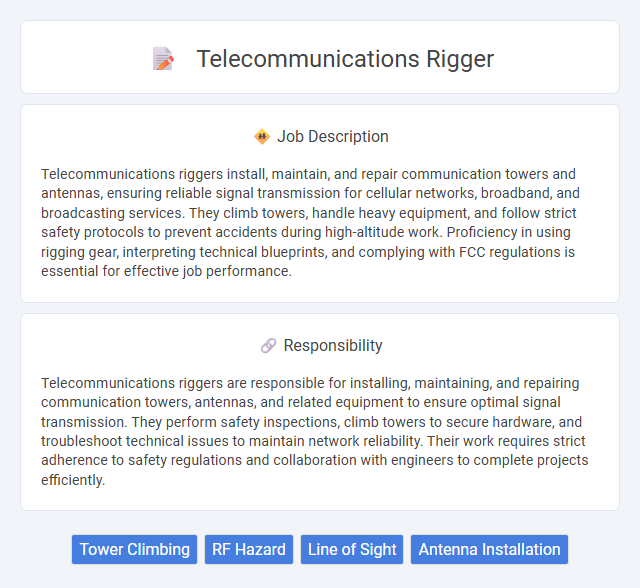
Telecommunications riggers install, maintain, and repair communication towers and antennas, ensuring reliable signal transmission for cellular networks, broadband, and broadcasting services. They climb towers, handle heavy equipment, and follow strict safety protocols to prevent accidents during high-altitude work. Proficiency in using rigging gear, interpreting technical blueprints, and complying with FCC regulations is essential for effective job performance.
Individuals with good physical stamina and comfort with heights are likely suitable for a telecommunications rigger job, as the role often involves climbing towers and working in outdoor environments. Those who are prone to vertigo, have poor balance, or struggle with physically demanding tasks may find this job challenging. A strong focus on safety and comfort with working in potentially hazardous conditions increases the probability of success in this career.
Qualification
Telecommunications riggers require a high school diploma or GED, with specialized training in tower climbing, safety protocols, and equipment handling. Certification from recognized organizations such as the National Commission for the Certification of Crane Operators (NCCCO) or Occupational Safety and Health Administration (OSHA) is often mandatory to ensure compliance with industry safety standards. Strong physical fitness, knowledge of rigging techniques, and experience with telecommunications hardware installation are essential for job performance and career advancement.
Responsibility
Telecommunications riggers are responsible for installing, maintaining, and repairing communication towers, antennas, and related equipment to ensure optimal signal transmission. They perform safety inspections, climb towers to secure hardware, and troubleshoot technical issues to maintain network reliability. Their work requires strict adherence to safety regulations and collaboration with engineers to complete projects efficiently.
Benefit
Telecommunications riggers likely experience significant benefits such as competitive salaries and opportunities for career advancement within the rapidly expanding telecom industry. They probably gain valuable hands-on experience with cutting-edge technology and safety protocols, which can enhance job security. The role may also offer travel opportunities and work in diverse environments, contributing to professional growth and personal development.
Challenge
Telecommunications riggers likely face significant challenges due to the physical demands and high-risk environments of working at elevated heights. The complexity of installing, maintaining, and repairing network equipment may require precise technical skills and constant vigilance to ensure safety. Weather conditions and tight deadlines could further increase the difficulty, making problem-solving and adaptability essential traits in this role.
Career Advancement
Telecommunications riggers install and maintain communication towers and antennas, playing a crucial role in the expanding telecommunications industry. Career advancement typically involves gaining certifications such as OSHA safety training and tower climber certification, enabling riggers to take on supervisory roles or specialize in high-voltage or fiber optic systems. With experience, riggers can progress to project managers, safety supervisors, or technical trainers, enhancing earning potential and leadership opportunities.
Key Terms
Tower Climbing
Telecommunications riggers specializing in tower climbing install, maintain, and repair communication antennas and equipment on cell towers often exceeding heights of 200 feet. They use advanced safety harnesses, climbing gear, and follow strict OSHA regulations to ensure secure ascents and descents while handling heavy cables and antennas. Expertise in tower structural integrity and signal transmission is essential to optimize network reliability and performance.
RF Hazard
A Telecommunications rigger working with antennas and towers faces significant RF hazard risks due to exposure to high-frequency electromagnetic fields emitted by transmitting equipment. Proper training in recognizing RF hazard zones, using personal protective equipment (PPE), and adhering to safety protocols is critical to prevent thermal injuries or long-term health effects. Regular site assessments and monitoring of RF exposure levels ensure compliance with OSHA and FCC safety standards to protect riggers during installation and maintenance tasks.
Line of Sight
Telecommunications riggers specializing in Line of Sight (LOS) installations ensure optimal signal transmission by precisely positioning antennas and equipment on towers or poles. Expertise in aligning microwave and radio frequency devices is critical for maintaining clear, unobstructed communication paths over long distances. Mastery of LOS technology enhances network reliability and reduces signal degradation in wireless communication systems.
Antenna Installation
Telecommunications riggers specialize in antenna installation, ensuring precise placement and secure mounting on towers or building rooftops to optimize signal transmission. They use specialized tools and safety equipment to handle heavy antennas and cables while adhering to strict industry standards and safety regulations. Expertise in reading technical blueprints, climbing tower structures, and troubleshooting signal issues is essential for efficient antenna deployment and maintenance.
 kuljobs.com
kuljobs.com